Researching his father’s WWII history became a passion for Steve Snyder
On February 8,1944 a B-17 ‘Susan Ruth’ was knocked out of the sky by German fighters over the French/Belgian border. Some men died. Some were captured and became prisoners of war. Some men evaded capture and were missing in action for months before making it back to England. Pilot Howard Snyder survived and was hidden by Belgian citizens before joining the French resistance. His son, Steve, has written a book about his father and the other crew members, titled Shot Down. We asked him some questions by e-mail about his book and further activities in relation to the legacy of his father and his crew.
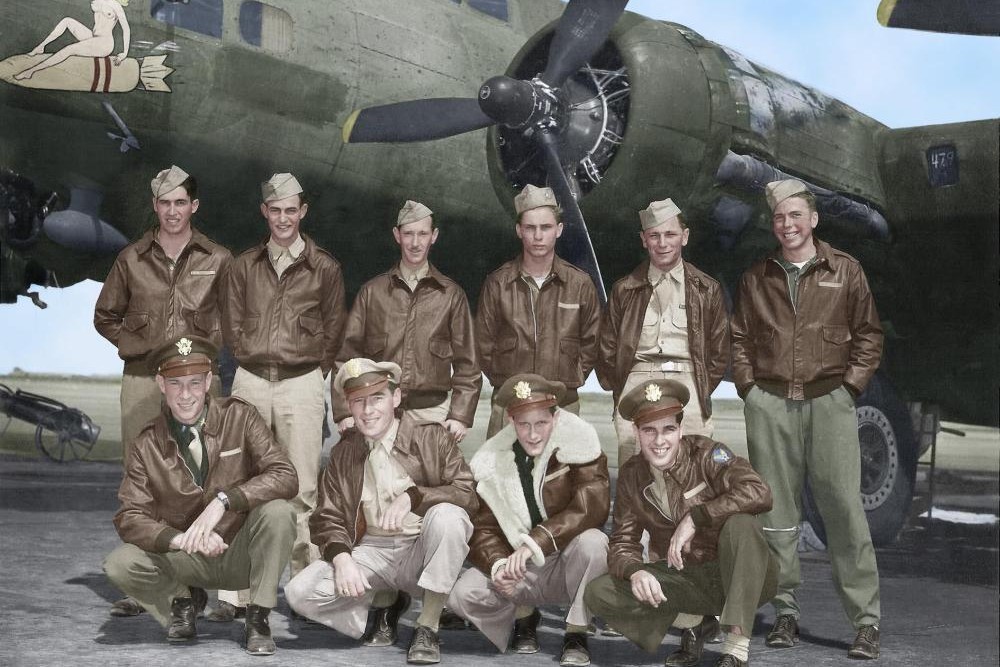
The crew of the 'Susan Ruth'. Source: Steve Snyder, Shot down
What kind of man was your father? In your youth, did he tell you about his war experiences?
My father was a big guy (for the time at 6' 2½") and a rugged, no-nonsense guy. He was a strong Christian with strict morals and viewed things as black and white. My sisters and I compared him to John Wayne. He was a loving husband and father, and we had a wonderful relationship and were very close.
Like most WWII veterans, he didn’t talk a lot about the war until 1989. The Belgian-American Foundation erected a memorial to my dad and his crew in Maquenoise, Belgium near the French border near where his B-17 came down. He and the other three members of his crew who were still alive and their wives attended the dedication ceremonies. There, he was reunited with Belgian people who hid him from the Germans and revisited places where he was hidden. The memories all came back, and he started talking about it. Five years later in 1994, I made my first trip to Belgium when my wife and I accompanied my parents to attend ceremonies for the 50th anniversary of the liberation of Belgium and my dad’s plane being shot down. That’s when it became personal for me.
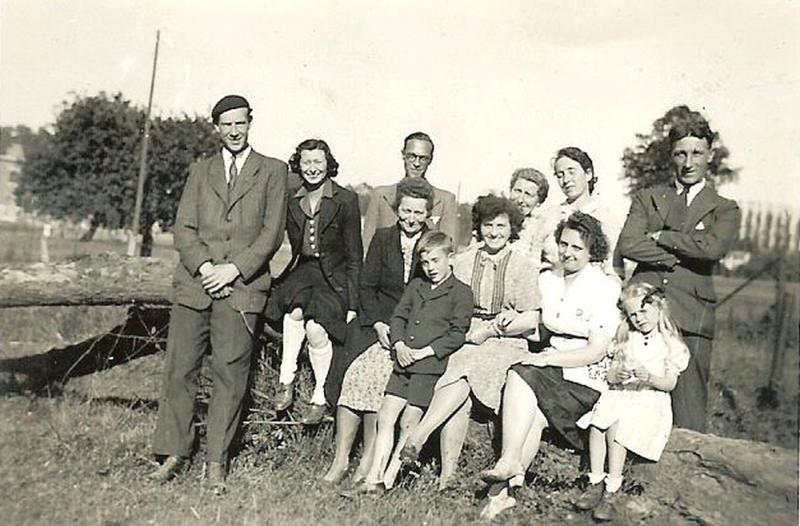
Howard Snyder with his Belgian helpers. Source: Steve Snyder, Shot down
When and why did you decide to write a book about your father and the other crew members of B-17 ‘Susan Ruth’?
While growing up, I knew the basics of my dad’s WWII history, but it wasn’t until I retired in 2009 that I had the time to really delve into it deeply. My parents had kept a lot of information about the war, and I just wanted to go through it, organize it, and learn more. Two items were really significant. One was a diary that my dad wrote while he was missing in action about his plane being shot down, which is absolutely riveting! The other were all the letters that my dad had written to my mother before being shot down. He was very candid in his letters; writing about what bombing missions were like, what life was like on the air base, what life was like in England and London, and escapades of him and his crew. Reading those letters was fascinating. It was like my father was speaking to me. It became my passion, and three years into my research, I came to the conclusion that the story of my dad and his crew was so unique and so compelling that it needed to be told so I wrote a book.
What sources did you use to construct the stories of all the crew members? What was the origin and background of the men?
I was so fortunate and so blessed to have an absolute wealth of detailed information. Naturally, I learned a lot directly from my father, but also from the other members of his crew who survived, through written and oral accounts. I also received stories from descendants of Belgian people who had hidden my dad.
A great deal of information was obtained from declassified military documents such as mission reports. missing air crew reports, 306th Bomb Group and Squadron Diaries, 306th Bomb Group Historical Association archives, a lengthy U.S. Army War Crimes Report, etc. I even found the German Luftwaffe pilot, Hans Berger, who shot down my dad’s plane and interviewed him for the book. He gave me some wonderful information about what it was like to go up against the Eighth Air Force and told me that the gunners on my dad’s crew shot him down at the same time he shot my dad’s plane down. They shot each down.
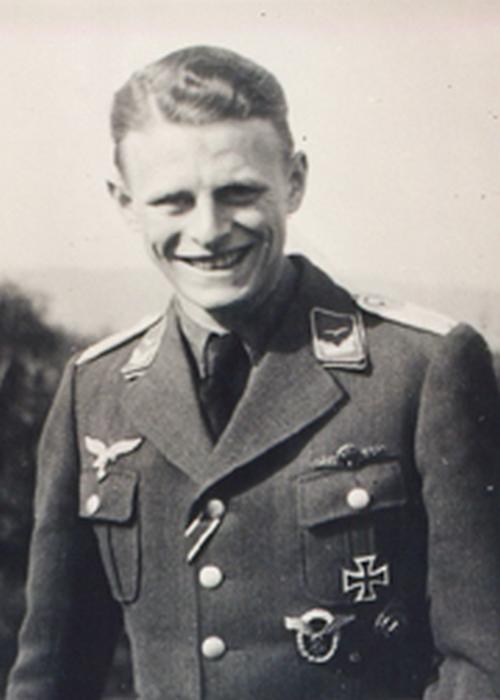
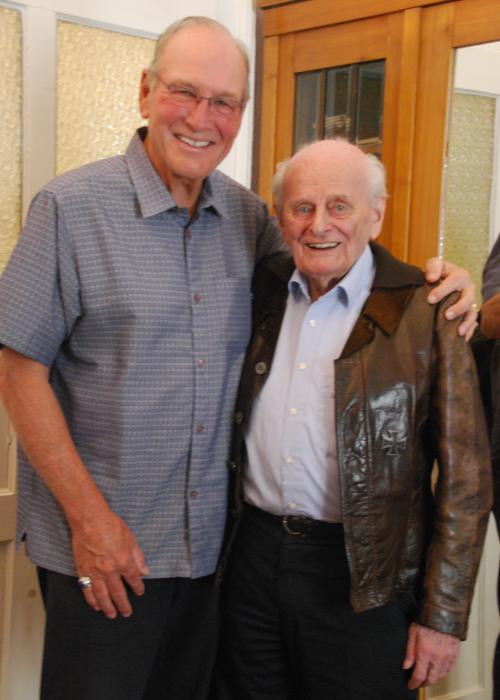
Left: Hans Berger during World War II. Right: Hans Berger with Steve Snyder. Source: Steve Snyder, Shot down
However, I could not have written it without the help of two Belgian men, Dr Paul Delahaye and Jacques Lalot, who were young boys during the war and greatly affected by it. Later in life, they became local historians and interviewed members of the Belgian Underground about events involving my dad and his crew and documented their testimonies. They gave me unbelievable detailed information that would have been lost forever without their dedicated research. The story is completely taken from firsthand testimony by the people who were involved in the events that took place. I did not add anything or embellish the story whatsoever. The only thing I added was historical information and anecdotes about and surrounding the war as background and to put the story in context.
Is there anything that struck you most during your research?
I gained an extremely deep appreciation for the courage and sacrifice, of not only my dad and his crew, but for all the men who served in the Eighth Air Force. Flying combat missions over Europe was brutal and extremely dangerous. Twenty-six thousand men died while serving in the Eighth Air Force which is more than the entire Marine Corps fighting in the Pacific. Another twenty-eighth thousand men became prisoners of war after their bombers were knocked out of the sky by German fighters or anti-aircraft fire. Being a combat crewman in the Eighth Air Force was the most dangerous duty assignment in the United States military during World War II.
Also, the bravery and guts it took for my father to come out of hiding and risk his life by joining the French Resistance to fight the Germans. I doubt very few men in his place would have had the courage to do that, but he felt it was his duty to get back in the fight. The safest thing would have been to stay put and wait for the U.S. Armies to come up through France and liberate that area.
Finally, finding Hans Berger and becoming friends was an unbelievable experience. Really a highlight of my life. I visited him twice in Munich, and had hoped to see him again this year, but he died in January at age 100.
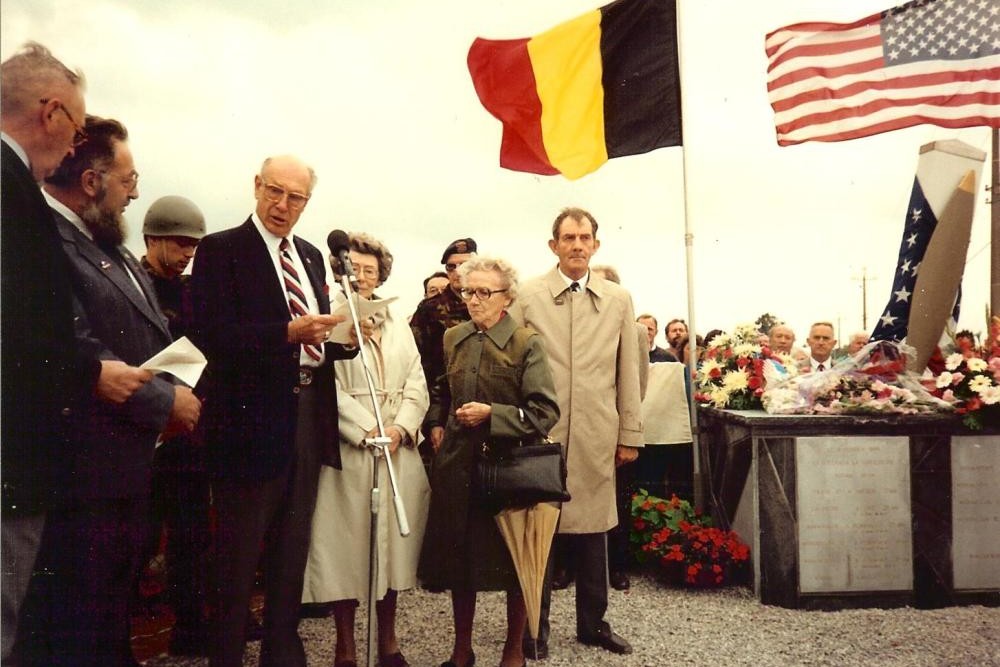
Howard Snyder at the dedication of the Suth Ruth Memorial in 1989. Source: Steve Snyder, Shot down
How did other relatives of crew members react to your research and book? Were they pleased that this history was documented by you?
During my research, I found relatives of all my dad’s crew and asked them for whatever information they could give me (letters, photos, newspaper articles, written accounts, etc). All were very cooperative, but sadly most of them knew very little about their loved ones’ time in the Eighth Air Force. They appreciated me doing all the research and writing the book so they could learn what their veteran experienced during the war. In 2014 and 2019, groups of crew relatives travelled to Belgium to attend anniversary ceremonies and visit locations involving their loved ones. Those trips resulted in developing special friendships, and I send out periodic emails to stay in touch and remember significant dates in the SHOT DOWN Story.
How is World War II history generally regarded in the United States? Do you think this is different from Western Europe?
It depends on the age group. Baby Boomers are extremely interested because they grew up after the war and knew World War II veterans as fathers, uncles, and cousins. There is also interest among their kids (Gen X and millennials) who knew their grandfathers or great uncles to various degrees. After them, there is very little interest in general, unless parents teach it to them. Sadly, the freedoms The Greatest Generation fought and died for are simply taken for granted today.
In my opinion, it is totally different in Western Europe. People in the UK know how close they came to speaking German. The country was attacked and suffered for six years. People in the occupied countries completely lost their freedoms, so they know what it was like to live under four years of oppression. They do not forget and teach their children not to forget. I have visited Belgium six times, and the people are still so thankful and grateful for the Americans and Allies coming to their rescue.
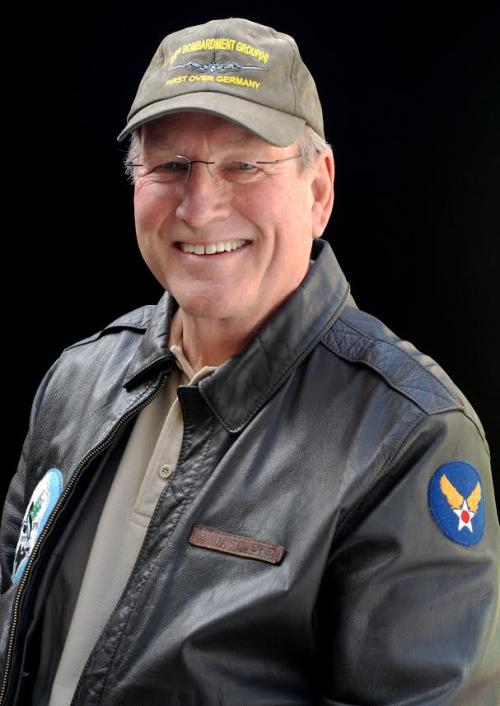
The mission of both organizations is to remember, honour, and educate. Remember the air war over Europe, honour the men who fought it, and educate the public about it.
As President of the 306th BGHA, I coordinate with the Board of Directors to hold annual reunions, hold periodic Zoom Board Meetings, publish a bi-annual newsletter, maintain our website and its extensive database, communicate with members through email and social media, and support the 306th Bombardment Group Museum in the UK.
My duties with the Eighth Air Force Historical Society are not quite as encompassing. We hold Zoom Board Meetings every other month, and I am the Reunion Chairman so am involved in planning and running our annual reunions. I also am involved in Eighth AFHS communications to our members and a member of a Joint Study Group of the Eighth AFHS and the National Museum of the Mighty Eight Air Force to develop a stronger partnership.
Personally, I make many PowerPoint presentations, attend air shows, and do interviews on podcasts throughout the year, to not only promote my book, but to educate people about the 306th Bomb Group, the Eighth Air Force, and the air war over Europe.
Next year marks the 80th anniversary of the end of the war in Europe. How will you celebrate this?
I have attended the 50th, 60th, 70th, and 75th anniversaries and so look forward to attending the 80th on August 30 & 31 and September 1 & 2. My entire family is going, seven of us in all, and a few other crew member relatives. The events take place in southern Belgium near the French border in Momignies and Chimay where the SHOT DOWN story took place. This are absolutely wonderful events which are so fun and very moving. There are lunches, dinners, band concerts, dances, U.S. army reenactors, plenty of Chimay beer, and everyone has a great time. Then there are numerous ceremonies at various memorial in the area to remember and honour the events that took place 80 years ago.
On April 30, ceremonies take place at several memorials to my dad’s B-17 crew and to the U.S. airmen who were murdered in the woods outside of Chimay. On August 31, a dedication for the Musee 40-44 Lt. Cook Museum renovation takes place. On September 1, there is a reenactment of the 9th U.S. Infantry crossing over the Wartoise River from France into Belgium to liberate the country on September 2, 1944. Finally, the big Liberation Day Ceremonies are on September 2 at memorials in Monceau-Imbrechies and Cendron for which the U.S. Ambassador to Belgium, Michal Adler, Embassy staff and representatives from SHAPE attend.
- Shot Down
- The true story of pilot Howard Snyder and the crew of the B-17 Susan Ruth
- ISBN: 9780986076015
- More information about this book

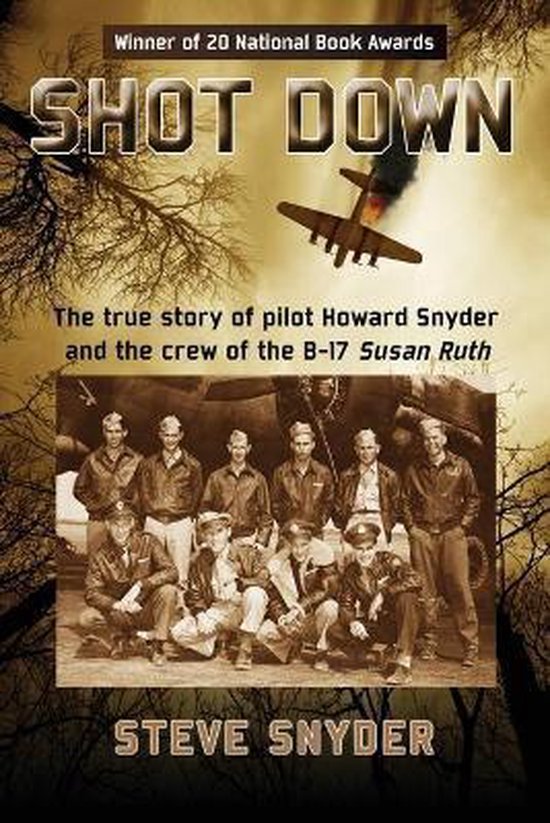
Used source(s)
- Source: Steve Snyder / TracesOfWar
- Published on: 25-08-2024 20:32:53
Related news
- 23-06: Keeping the memory of the trails to freedom alive
- 12-04: Understanding the German side of the fighting in Normandy
- 11-'24: Postal artifacts provide a vibrant testament to the experiences of the Dutch people during WWII
- 10-'24: DigitalBattlefieldTours unlocks military tactics to a wide audience
- 08-'24: Who was the owner of the photo album from Dachau?
Latest news
- 03-10: Photo report other Airborne commemorations and events 2025
- 01-10: Photo report commemoration Wiltshire memorial
- 30-09: Photo report other Airborne commemorations and events 2025
- 26-09: Photo report Ounveiling Plaque 'Gunners within 1st Airborne Division'
- 25-09: Photo report unveiling Plaque 'Gunners within 1st Airborne Division'
- 24-09: Photo report Airborne commemoration Driel
- 23-09: Photo report Airborne Landing and Commemoration
- 22-09: Photo report Airborne Memorial Service Oosterbeek
- 23-06: Keeping the memory of the trails to freedom alive
- 12-04: Understanding the German side of the fighting in Normandy

